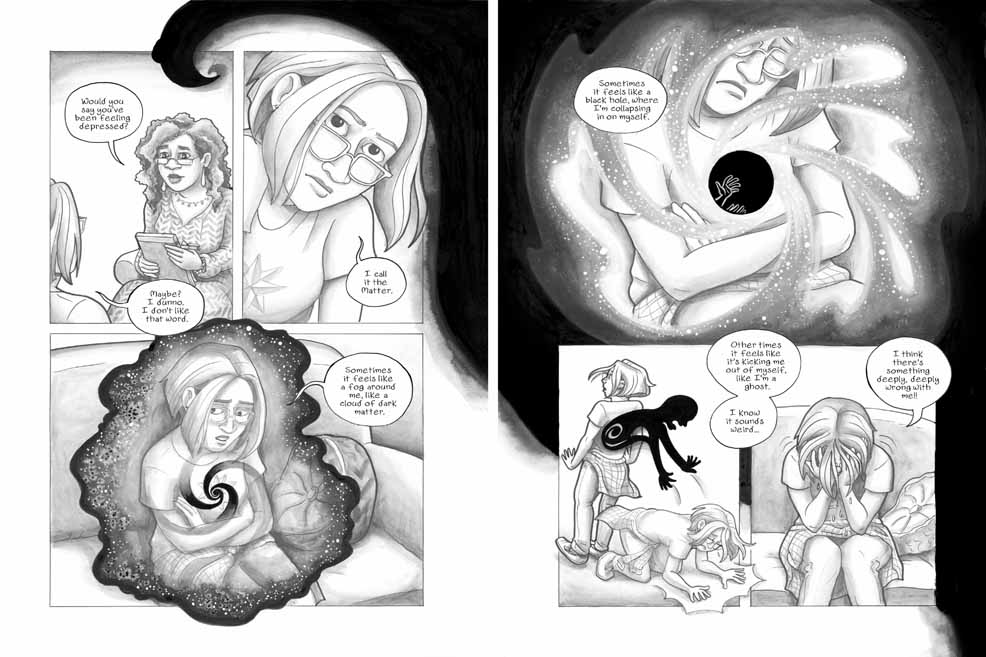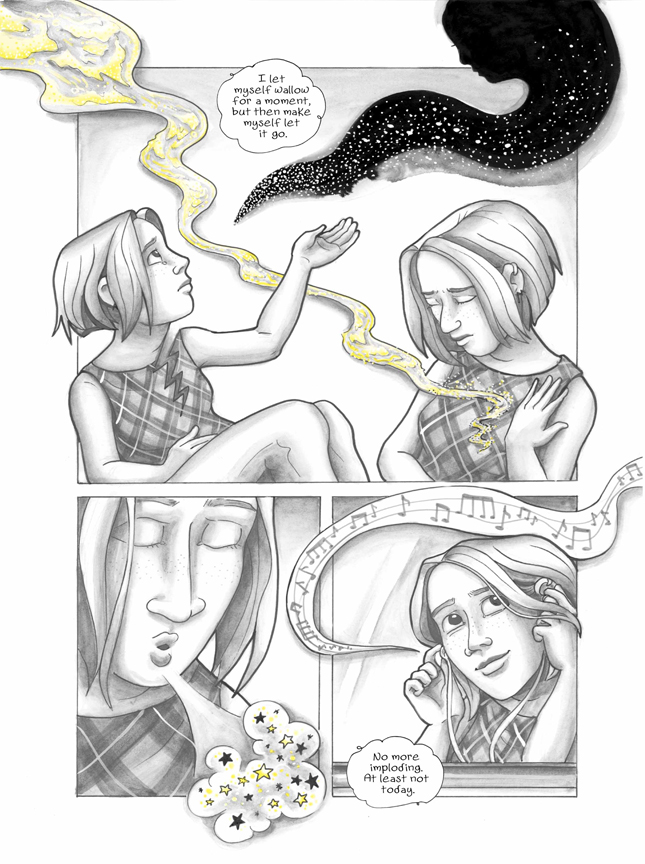Interview: Laura Lee Gulledge on The Dark Matter of Mona Starr
Laura Lee Gulledge is the Eisner and Harvey Award nominated creator of the young adult graphic novels Page By Paige and Will & Whit, she encourages creativity with Sketchbook Dares: 24 Ways to Draw Out Your Inner Artist, and is a teaching artist and guest speaker. Her latest work, The Dark Matter of Mona Starr, tells the story of a highly sensitive teenager and her struggles with depression, which she calls her Matter. Westfield’s Roger Ash recently spoke with Gulledge to learn more about this intriguing book.
Westfield: Where did the idea for The Dark Matter of Mona Starr come from?
Laura Lee Gulledge: It started as a completely other story. I was trying to make a tale about hope and healing, but it was less personal. It was more of an ensemble story with magical elements. My publisher said, “we don’t want all these bells and whistles. We just want this depressive violinist. We want her story.” It’s always the thing you don’t want to talk about that people want from you. As an artist, my brand is not cool, it’s vulnerable. So I stripped away everything and just sat with Mona, which is really sitting with past tense me. It took a couple years of thinking about it to work up to really getting into her story. I didn’t want to get depressed making a story about depression. How do we find the hope in her story? This is not a story about depression, it’s a story about hope and healing.
Westfield: Who is Mona?
Gulledge: Mona is a 14 year old geek girl in Northern Virginia. She is based on high school me. She looks like me. She’s in orchestra. She is creative. She’s smart and funny but she’s highly sensitive. Her best friend moves away. A problem I always had in school was that between elementary, middle, and middle of high school, all of my friends went to different schools so I always had to start over. It felt pointless. Why do I try to make new friends when I’m just going to lose them? She’s like me in that we can get isolated, a little stuck in our heads. But, of course, there’s a new girl that comes to her school and Mona falls in artner love with her and that pulls her out of her isolation.
It was a challenge because I was not depressed in high school. I got hit more in college. Taking some of the emotions I felt later and adapting it to a younger person was difficult. I feel like people are getting depressed earlier now because the world is more overwhelming and scary and challenging in these times versus in the ‘90s when it was more of a time of abundance.
Westfield: Who are some of the other character’s in the book?
Gulledge: Her best friend Nash has moved away but they still keep in touch. Her standmate in orchestra is Aiesha. They’re not super close at the beginning because they both have their own stuff going on, but they become better friends throughout the book. In my life, I would feel alone but think “why don’t you reach out to the person who’s already there?” The new girl is Hayley, who plays the cello. It sort of is about the three of them. It’s like three loners coming together to create a friendship. To create community. I always felt like a bit of a loner so connecting with other people who feel isolated is positive. There’s also her therapist, her parents, and her orchestra teacher.
Westfield: You’ve dealt with depression before in your book Drawn Thru: Drawing Thru Depression. What is there about depression that keeps you bringing it back as a story element?
Gulledge: I don’t like the word depression because I don’t want to act like I’m an authority. I’m not clinically depressed. I don’t want to pretend to be someone who’s dealing with that day to day struggle. My label is I’m a highly sensitive person; an HSP. That just means that I feel the feels. I have highs and lows and things really affect me. I have had periods of depression in my life. The Drawn Thru collection of artwork was definitely a period where I was depressed. I was down a well. I’m not always that way. It’s definitely the ups and downs.
I think that’s why I label depression as The Matter and personify it that way in the book. Also, I like to make up new words for things for myself. I don’t like the word collaborator; I use artner. I feel that certain words have different meanings to everybody and depression is a very charged word. In some ways, as an artist I feel like finding new ways to talk about things is part of my job. I’m not a licensed mental health professional, so I I try to address it mental illness a very personal way. That’s the best I can do. But it’s not the same experience for everybody. Sure, I have a lot of feelings and emotions. I don’t have more than other people, I’m just really good at drawing about them. When I am feeling depressed, it’s a time when I can do some reflection. I can tell myself this is not going to last forever. I know I don’t deserve to feel like this. I know I’m choosing to isolate myself, it’s not that other people don’t like me. I’ve been up and down enough, now I can handle being down a little more because I can explore why I feel like this. Journaling about it when you are feeling down, for me is an amazing resource. You feel more like doing that soul searching when you’re down rather than when you’re up and you feel great. When you feel great, you don’t want to sit and draw about it, you want to go out and live life. People tend to relate more to my art that is sad or struggling rather than the happier art. I hate to say it, but that’s what resonates a lot with people. People are dealing with a lot right now and words sometimes just don’t cut it. So if I can find a way to draw pictures about it so that it can help someone else with their experience, then that’s my gift.
Westfield: Any closing comments?
Gulledge: It’s definitely my most personal book yet. For example, I noticed in my previous books that I didn’t have scenes in bathrooms. I didn’t have scenes with characters dealing with the physicality of being human, even eating. I tried to do all the things I hadn’t explored before. Mona’s crying a lot. She’s also vomiting and in the hospital. I have more characters with glasses because glasses are hard to draw. Even having the character in orchestra meant I had to draw the entire orchestra. Basically, I wrote a script that terrified me. What would be best for the story but most intimidating for me? That’s what I’m gonna write. Then I was drawing and it was like, “who wrote this script?” Since the content was so vulnerable, I felt I needed to be as vulnerable as possible as a creator and not keep it easy for myself. I think it taught me a lot.
I hope that other people can find her story hopeful. In the back of the book I have my selfcare plan and a blank one so that the reader is encouraged to take account of what they know helps them. Who’s in their support system they can talk to. I’m hoping it’s not too self helpy, but I think it’s really important to have some action steps with this story. Mona is sort of modeling what to do when you get hit by all the feels; how to climb back out of the well. We’re all going to fall down the well sometimes. But knowing what to do when you’re in that situation and thinking ahead is important. When I’m not feeling well, I don’t think straight. I can’t make smart decisions; I’ll choose things that are bad for me. Having a post-it with “take a shower, make some tea, light some incense, and put on some music” creates a scene change. I hope it can start some conversations.




USER COMMENTS
We'd love to hear from you, feel free to add to the discussion!